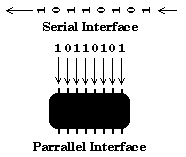

MIDI, which means:
is a digital communications protocol. In August of 1983, music manufacturers
agreed on a document that is called "MIDI 1.0 Specification".
Any device that has MIDI capabilities must adhere to this specific data
structure to ensure that all MIDI devices are capable of working together.
This protocol is a language that allows interworking between instruments
from different manufacturers by providing a link that is capable of transmitting
and receiving digital data. It is important to remember that MIDI transmits
commands, but it does not transmit an audio signal.
The MIDI specification includes a common language that provides information
about events, such as note on and off, preset changes, sustain pedal, pitch
bend, and timing information. The specification has been updated more recently
with specific data structures for handling sample dumps, MIDI time code,
general MIDI and standard MIDI files. To see a complete listing of all MIDI
data, go to: Types of Data Transmitted through MIDI

MIDI information is transmitted through a MIDI cable that has DIN-type male
plug connectors with five pins. Two of the pins are used to transfer digital
binary information (MIDI Code). One of the pins issues a steady stream of
five volts, while the other pin alternates between 5 volts and 0 volts to
represent binary information (on and off). The third pin is a ground and
the remaining two pins are currently not in use.
 |
|
| The MIDI data is sent down the cable one bit at a time as a stream of information, which is called a serial interface. A parallel interface allows the information to be sent down separate wires so that the message reaches the device at the same time, making it faster than a serial interface. Computer chips communicate via a parallel interface. | |
| The serial interface was chosen by MIDI manufacturers because it is less expensive and more efficient than a parallel interface. The speed of a MIDI serial interface is 31,250 bits per second. There are 10 bits needed for every MIDI digital word or 3125 messages per second. Snap your finger and think about how many many events could be transmitted during that time. Consequently, the serial interface speed is more than adequate for most music applications. | In order to really understand the concept of digital information, we must be familiar with the decimal, binary and hexadecimal counting systems. Understanding Decimal, Binary,& Hexadecimal, will help us to learn about the three counting systems and how they are applied to MIDI communication. |